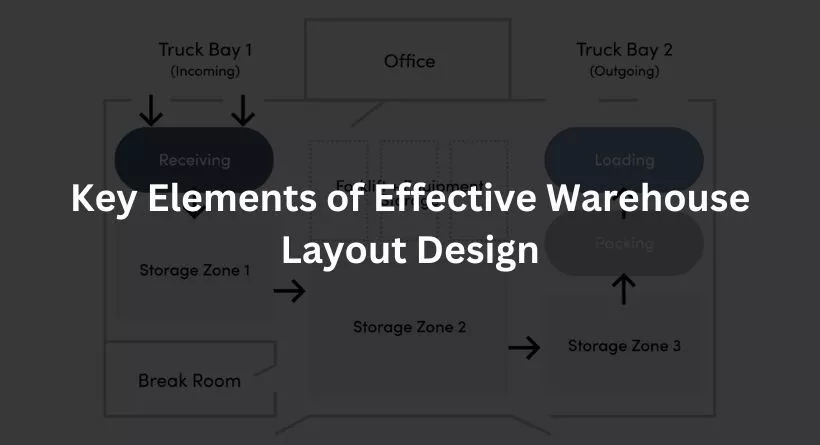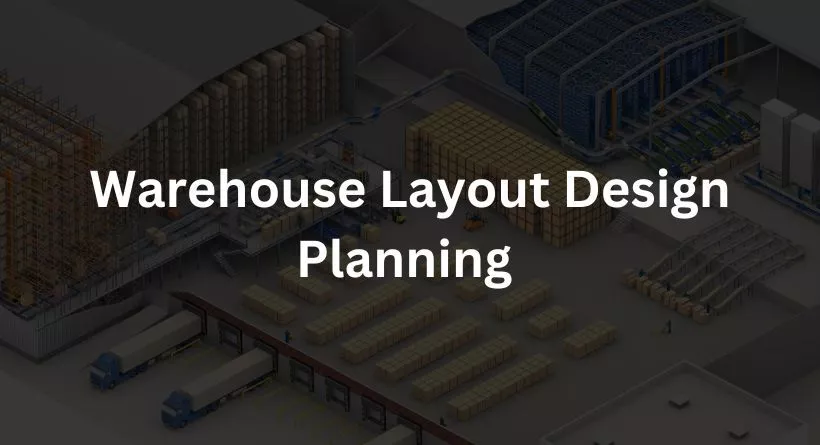Dealing with warehouse layout design can be an overwhelming task. If you’re reading this, it’s likely you’ve experienced the challenges of maximizing your warehouse space and streamlining operations for improved efficiency. Well, you’re not alone. It’s a common problem faced by many businesses, especially in 2023 with the rapidly evolving industrial landscape. However, fret not, because there’s a solution to this complex problem. In this blog post, we promise to share a practical, step-by-step guide that will help you plan your warehouse layout design effectively.
By laying out the principles and methods of warehouse layout planning, we aim to alleviate your concerns. We’ll cover the key aspects of this process, highlighting how they can positively impact your business operations. Whether you’re setting up a new warehouse or revamping an existing one, you’ll find this guide indispensable.
Having a well-organized warehouse is crucial for your business. It can impact not just the efficiency of operations but also the satisfaction of your employees. And let’s face it – who wouldn’t want to work in a well-planned, clutter-free environment? It’s time to address the chaos and transform it into a well-oiled machine. Let’s dive into the world of warehouse layout design and find solutions that work best for you.
Understanding Warehouse Layout Design
Let’s delve into the fascinating world of warehouse design. In essence, what is a warehouse layout design? Simply put, it’s the arrangement of physical elements within your warehouse that aims to streamline operations. This includes the placement of shelves, loading docks, equipment, and even the paths your employees take to complete their tasks.
Now, why does this matter? Here’s the crux of the issue – a well-planned warehouse layout design is a pivotal component in the supply chain process. It can significantly enhance operational efficiency, improve inventory control, and elevate safety standards.
What is a Warehouse Layout Design?
The backbone of a thriving warehouse is its layout design. It’s the blueprint that dictates how space, equipment, and people are arranged within the confines of a warehouse. The design is carefully mapped to ensure optimal use of space while promoting safety and fostering a smooth workflow. For example, imagine an efficient warehouse like a well-orchestrated dance, where every element knows its place, timing, and movement. That’s the magic a well-executed warehouse layout design brings.
Importance of a Proper Warehouse Layout Design
Now, you may wonder, why is a proper warehouse layout design so crucial?
First and foremost, it fuels efficiency. An appropriately designed warehouse optimizes the flow of goods and minimizes unnecessary movement, thus reducing the time taken for tasks like picking, packing, and shipping. Picture this – if your warehouse layout design is a well-planned city map, then your goods are the vehicles, flowing seamlessly from one point to another without traffic jams or detours.
Moreover, it contributes to inventory control. With a clear view of your stock and easier access to items, managing inventory becomes a breeze. Think of your warehouse as a vast library, and your inventory as books. A solid warehouse layout ensures that every ‘book’ is readily found and accounted for, just like a well-managed library catalog.
Challenges in Warehouse Layout Design
Stepping onto the stage of warehouse layout design, it’s essential to be aware of potential pitfalls. Familiarizing yourself with common challenges can guide you in creating a smoother, more efficient design.
Common Issues in Warehouse Layout Design
Several key issues tend to arise during the warehouse layout design process. Overcrowding can be a significant problem, where an excess of inventory hinders efficient movement and operation. Consider a bustling city center during rush hour, not the ideal setting for efficiency, right?
Additionally, an inefficient flow can lead to wasted time and energy, much like a river that meanders aimlessly without reaching the sea. Furthermore, poor visibility of inventory items can also occur, akin to trying to find a single star in the vast night sky. It’s a daunting task indeed!
Impact of Poor Warehouse Layout Design
The repercussions of a poorly designed warehouse layout can ripple through your entire operation. It can lead to inefficient processes, similar to an engine running without proper oiling. Not only can this slow down your operations, but it can also result in increased costs.
Moreover, it can cause safety issues, creating an environment rife with the potential for accidents. Picture a busy intersection with no traffic signals, and you can easily understand the kind of chaos that might ensue.
Key Elements of Effective Warehouse Layout Design

Now that we’ve navigated through the potential challenges, let’s turn the spotlight on the key elements that make up an effective warehouse layout design.
Space Optimization
Effective use of available space is the cornerstone of any warehouse layout design. Much like packing a suitcase for a long trip, every square foot counts. Thoughtfully placing racks and aisles can dramatically improve the use of your warehouse space.
Warehouse Flow
The flow within your warehouse is another crucial element. It should be as smooth as a well-rehearsed symphony, allowing for quick and easy movement of goods. Good flow reduces bottlenecks, ensuring your operations proceed without a hitch.
Picking Methodologies
The picking methodology is an essential component of your warehouse design. Imagine it like a treasure hunt – the right methodology helps you find your ‘treasure’ faster and more efficiently.
Employee Safety
Last but not least, employee safety is paramount. Your warehouse should be like a safe haven, ensuring the well-being of everyone within its walls. This can be achieved through clear aisles, proper lighting, and safety signage.
Embarking on the journey of warehouse layout design may seem daunting, but with awareness of potential challenges and a focus on key elements, you can create an efficient, safe, and effective warehouse. Your warehouse is more than just a storage space; it’s a finely tuned instrument, and with the right layout, it can hit all the right notes.
Steps to Plan Your Warehouse Layout
Crafting an effective warehouse layout might seem like a puzzle, but with the right steps, you can assemble it into a complete picture. Here’s a roadmap to guide you through this journey.
Assessing Your Needs
The first step is understanding your needs. It’s like identifying the ingredients for a recipe. Knowing the nature of your inventory, the size of your operations, and the characteristics of your workforce can provide invaluable insights to design your warehouse layout.
Mapping Your Space
The next step is space mapping. Imagine you’re creating a treasure map. The goal here is to design the most efficient routes to navigate your warehouse, making sure each square foot is used effectively.
Optimizing for Efficiency
The final stage is optimizing for efficiency. Consider it as fine-tuning an instrument. This involves adjusting your layout for smooth flow, easy accessibility, and superior safety. With this, your warehouse layout can reach its peak performance.
Case Study: Warehouse Layout Design Success Story
To truly appreciate the impact of a well-designed warehouse layout, let’s examine a real-life success story. XYZ Distribution, a mid-sized retail company, redesigned their warehouse layout. With smart space optimization and improved flow, they reduced their order processing time by 35%. It’s akin to a marathon runner finding a new, efficient path and cutting their race time dramatically.
You may also like reading: The Best Home Inspector Training Programs of 2023
Latest Trends in Warehouse Layout Design in 2023

As we tread into the future, the landscape of warehouse layout design is evolving, influenced by the steady march of technology.
Impact of Technology
Today’s technology is revolutionizing the way warehouses operate. Autonomous mobile robots, IoT devices, and AI-driven software are now commonplace. Picture your warehouse transforming into a smart city, with traffic (goods) managed by intelligent systems for ultimate efficiency.
Future Warehouse Layout Designs
Future warehouse designs are becoming more flexible, adaptive, and tech-integrated. Consider this as the evolution of a smartphone, growing smarter and more versatile with each generation. These designs aim to harness the power of technology to ensure efficiency, scalability, and sustainability in operations.
The world of warehouse layout design is as vast and intriguing as an unexplored planet. By understanding the intricacies involved, embracing the challenges, and keeping up with the trends, you can design a warehouse that’s not just a storage space but an efficient, safe, and productive powerhouse.
Conclusion
To wrap up our in-depth exploration into warehouse layout design, it’s clear that this process is an intricate dance. From understanding the importance of a well-designed warehouse layout to identifying challenges, we’ve uncovered the key elements that contribute to an effective design. We’ve also journeyed through the steps to plan your own layout, drawing inspiration from real-life success stories. Lastly, we’ve glanced into the future, noting the rising influence of technology and the shift toward more adaptive designs.
Remember, creating an efficient warehouse layout is like crafting a beautiful symphony. Every element needs to play its part, in harmony, to achieve a smooth and efficient performance. As you step forward on this path, equipped with knowledge and insights, remember that every challenge is a stepping stone toward creating a warehouse that truly sings with efficiency and safety.

